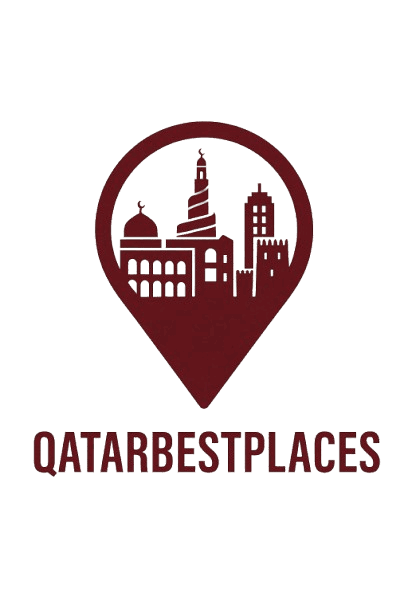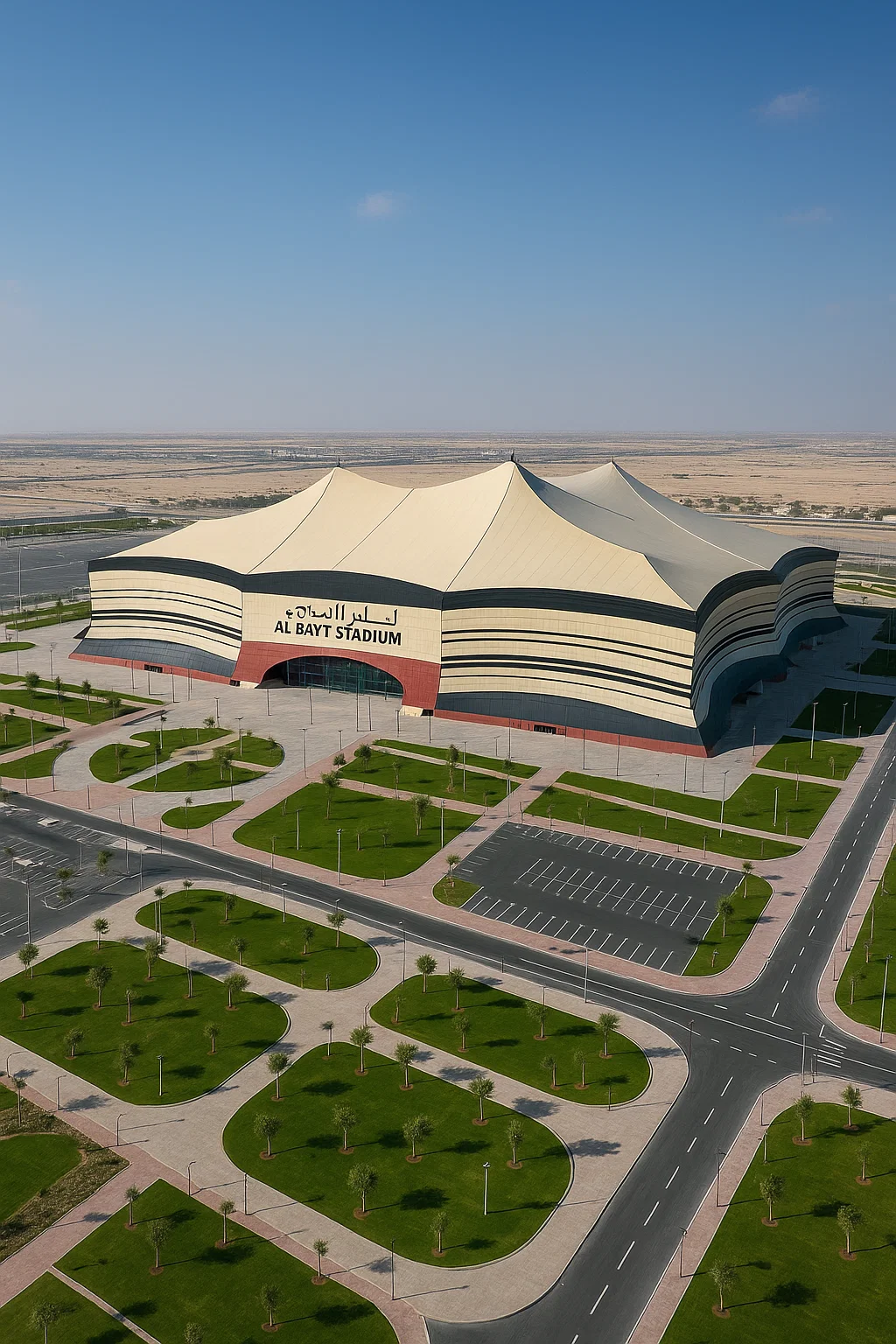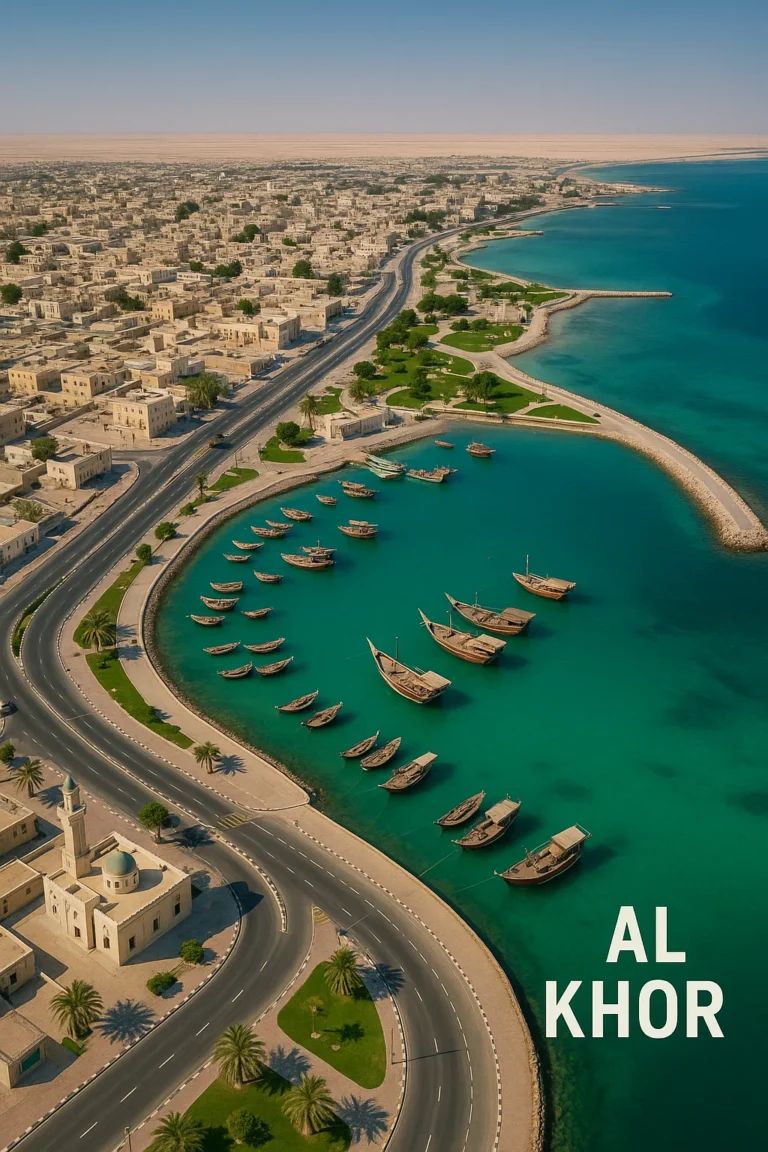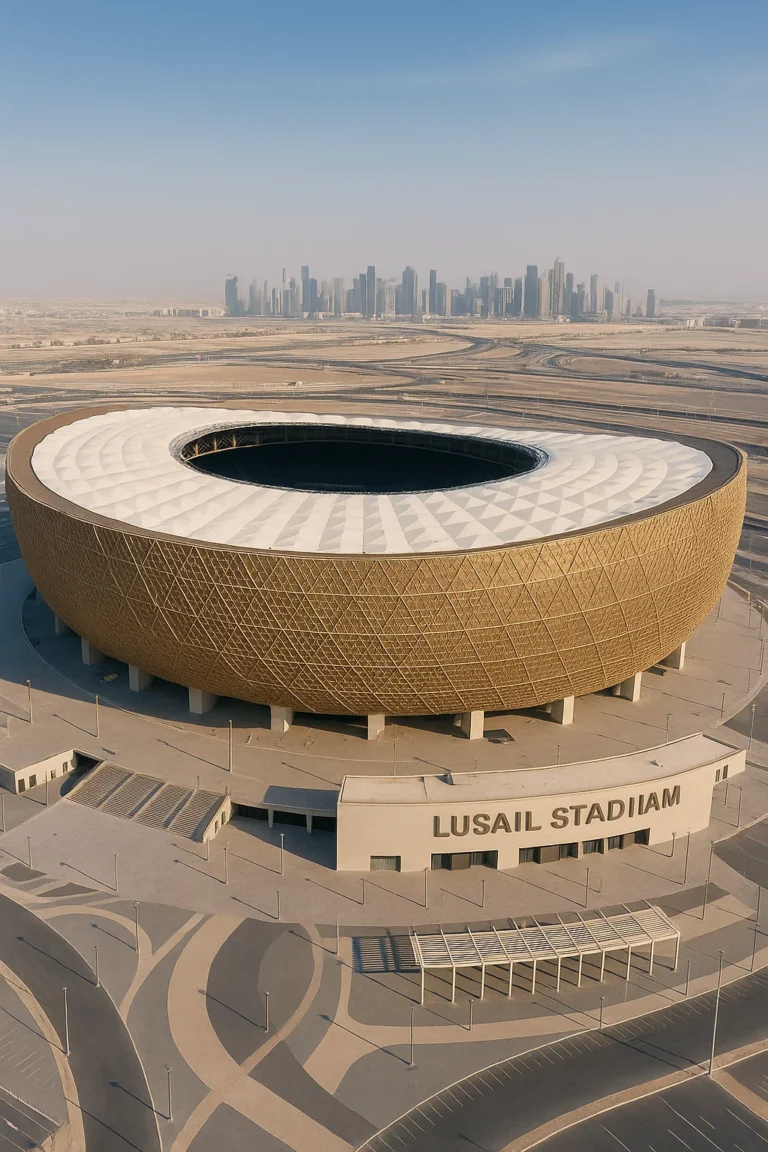Al Bayt Stadium: Qatar’s Iconic Desert Tent – Where Tradition Meets Innovation
When the sun sets over the quiet city of Al Khor, a glimmering structure rises from the sand dunes like a mirage — vast, geometric, and unmistakably Qatari. Al Bayt Stadium, one of the most breathtaking architectural feats in modern sport, isn’t just a football arena. It’s a living tribute to Qatar’s desert heritage, a sustainable engineering marvel, and a cultural symbol of Arab hospitality.
As one of the crown jewels of the FIFA World Cup Qatar 2022™, and now a key venue for the upcoming FIFA Arab Cup Qatar 2025™, this colossal structure continues to host the region’s biggest events while embodying Qatar’s ambitious sporting legacy.
📍 Location and Overview
Location: Al Khor, Qatar
Distance from Doha: 35 km north of the capital
Opened: 30 November 2021
Architect: gmp Architekten von Gerkan, Marg und Partner (in collaboration with Dar Al-Handasah)
Capacity: 68,895 seats
Cost: Approx. USD 847 million
Surface: Natural grass
Roof: Retractable
Record Attendance: 68,895 – Spain vs Germany (27 Nov 2022)
Visible for miles across the desert horizon, Al Bayt Stadium is both a cultural monument and a state-of-the-art sports venue. Its name, Al Bayt – meaning “The Home” – is a heartfelt nod to the Bedouin tent (bayt al sha’ar), the traditional black-and-white dwelling that sheltered generations of nomads traveling across the harsh Arabian desert.
History and Construction
Construction of Al Bayt Stadium began in September 2015 and took over six years to complete. Designed to reflect Qatar’s commitment to sustainability and innovation, it became one of the first venues completed for the World Cup.
The official inauguration took place on 30 November 2021, coinciding with the FIFA Arab Cup Qatar 2021™ opening ceremony, attended by His Highness Sheikh Tamim bin Hamad Al Thani, the Emir of Qatar.
When the FIFA World Cup Qatar 2022™ kicked off, it was Al Bayt Stadium that took center stage, hosting the opening match between Qatar and Ecuador. Its retractable roof, vibrant red interior, and massive capacity created an unforgettable first impression for millions of global viewers.
Architectural Design – The Desert Tent Reimagined
The stadium’s architecture is its soul. Inspired by Bedouin tents, Al Bayt’s striking black-and-white striped exterior instantly stands out in the desert landscape.
- Symbolism: The design pays homage to Qatari hospitality and nomadic culture, embodying warmth, welcome, and unity.
- Exterior: The tent-like structure covers both the stadium and a surrounding exhibition area, spanning 372.5 × 310 meters.
- Interior: Inside, the seating bowl is drenched in deep red hues, decorated with Al Sadu weaving patterns — traditional Bedouin motifs woven into carpets and tents for centuries.
- Roof: A fully retractable membrane roof allows the venue to transform from open-air to enclosed within minutes, adapting to Qatar’s varying weather.
The entire structural system combines steel cables, concrete piers, and tensile fabric, forming one of the world’s most advanced cable-membrane roofs.
Engineering Marvel and Sustainability
Al Bayt Stadium received a Class A* certification from the Global Sustainability Assessment System (GSAS), highlighting its eco-friendly design. Every element of its construction was guided by sustainability — from energy efficiency to water conservation.
Key sustainability features include:
Green materials:
Eco-friendly and recyclable construction materials were used throughout the project.
Cooling technology:
A 55,000 TR district cooling plant keeps the stadium comfortable year-round. Using ice storage tanks, glycol chillers, and thermal-energy storage, the system minimizes power use while maintaining a pleasant atmosphere for players and fans.
Solar integration:
Solar panels provide power for lighting and ventilation systems, reducing the carbon footprint.
Water recycling:
A wastewater treatment plant (capacity 1,000 m³/day) supports irrigation for nearby green areas.
Smart transport design:
Advanced traffic and parking models encourage visitors to use public transport, aligning with Qatar’s Green 2022 Vision. The stadium connects easily to Doha Metro’s Red Line (via Lusail QNB Station) and offers dedicated park-and-ride options.
Structure and Scale
Al Bayt Stadium is not only vast — it’s a structural masterpiece.
- The stadium bowl contains three basements, a ground floor, and three upper levels.
- It houses separate VIP zones, lounges, media areas, and athlete facilities.
- The tent canopy extends over the seating bowl and exhibition areas, shielding spectators from intense desert heat.
- The field size matches FIFA’s global standard – 105 × 68 meters.
The total project cost reached approximately USD 847 million, reflecting both the scale and sophistication of the venue.
A Sustainable Legacy Beyond the World Cup
Qatar built Al Bayt Stadium with long-term community transformation in mind. After hosting the world’s biggest football events, large sections of the stadium are being repurposed.
- The upper tier of seats (around 30,000 capacity) will be dismantled and donated to developing nations in need of sporting infrastructure.
- The main structure will transform into a mixed-use complex, housing schools, shops, medical clinics, and cafés, ensuring that the stadium continues serving local communities for generations.
This concept of sustainable downsizing is central to Qatar’s legacy plan — a bold contrast to “white-elephant” stadiums left idle after major tournaments elsewhere.
Memorable Matches and Events
During the FIFA World Cup Qatar 2022™, Al Bayt Stadium hosted some of the tournament’s most dramatic fixtures:
- Opening Match: Qatar vs Ecuador (20 Nov 2022)
- Spain vs Germany: Group E classic (27 Nov 2022)
- England vs France: Quarter-final thriller (10 Dec 2022)
- Multiple knockout-round matches that drew record-breaking attendances of 68,895 fans.
It also hosted key FIFA Arab Cup Qatar 2021™ fixtures — a symbolic prelude to its role in FIFA Arab Cup Qatar 2025™, where it will once again host the opening ceremony and high-profile group matches.
Highlights of Al Bayt Stadium
| Feature | Description |
|---|---|
| Capacity | 68,895 seats (fully expandable) |
| Roof Type | Retractable, cable-membrane structure |
| Design Theme | Bedouin Tent – Bayt al Sha’ar |
| Sustainability Rating | GSAS Class A* |
| Construction Period | 2015 – 2021 |
| Cost Estimate | USD 847 million |
| Architects | gmp Architekten / Dar Al-Handasah |
| Contractors | Galfar Al Misnad / Webuild S.p.A. / Cimolai |
| Field Size | 105 × 68 m |
| Nearby Attractions | Al Khor Park, Panda House, Purple Island, Inland Sea |
Getting There – How to Reach Al Bayt Stadium
Located about 35 km north of Doha, Al Bayt Stadium is easily reachable via multiple transport modes:
By Car or Taxi:
A 40-minute drive from central Doha via Al Khor Coastal Road.
By Metro:
Take the Red Line to Lusail QNB Station, then a connecting shuttle or bus service directly to the stadium.
By Bus:
Public transport and dedicated FIFA shuttle routes operate on matchdays and major events.
The Experience – Desert Oasis Meets Futuristic Design
Approaching Al Bayt Stadium feels like stepping into a desert dreamscape. The ring road surrounding the venue isolates it visually, creating the illusion of a modern oasis in the sand. At night, the illuminated fabric tent glows softly, while the inner bowl pulsates with life and sound.
Inside, fans experience a perfect blend of comfort and culture. Cool air circulates evenly through advanced cooling vents, while the red Al Sadu-patterned seats surround the pitch in a mosaic of tradition. The retractable roof adjusts to sunlight, preserving the desert’s mystique even under artificial light.
🏆 Al Bayt Stadium in Qatar’s Stadium Legacy
Al Bayt Stadium is part of an extraordinary network of venues that redefined global stadium design. Other key venues include:
- Lusail Stadium: Qatar’s largest arena (88,966 capacity) – hosted the 2022 World Cup Final and will host the Arab Cup 2025 Final.
- Ahmad Bin Ali Stadium: Gateway to the desert and home to Al Rayyan SC.
- Al Thumama Stadium: Inspired by the ghafiya cap – a symbol of Arab identity.
- Al Janoub Stadium: Zaha Hadid’s marine-inspired design in Al Wakrah.
- Education City Stadium: “The Diamond in the Desert”, surrounded by university campuses.
- Khalifa International Stadium: Qatar’s historic national stadium.
- Stadium 974: The world’s first fully modular stadium, built from shipping containers.
Together, these venues earned global acclaim for innovation, comfort, and sustainability, cementing Qatar’s position as a pioneer in sports architecture.
Visitor Experience and Tours
Fans can visit Al Bayt Stadium year-round. Guided tours include access to:
- VIP and media lounges
- Player tunnels and locker rooms
- Museum exhibits about Qatar’s sporting journey
- Observation decks overlooking Al Khor and the coastline
Tip: Visit at sunset – the stadium’s gold-red glow under the evening sky is a photographer’s dream.
Nearby Attractions
- Al Khor Park & Zoo: Family-friendly spot with gardens and wildlife zones.
- Purple Island: A natural mangrove sanctuary perfect for kayaking and bird-watching.
- Panda House at Al Khor: Home to the first pair of giant pandas in the Middle East.
- Inland Sea (Khor Al Adaid): UNESCO heritage site where desert meets the sea.
Future of Al Bayt Stadium
As Qatar continues to host major tournaments like the FIFA Arab Cup 2025™, AFC Asian Cup 2027™, and more global events, Al Bayt Stadium remains a cornerstone of the nation’s sports vision.
Beyond football, it’s envisioned as a multi-purpose cultural hub, integrating education, community services, and leisure facilities — redefining what a “stadium” can mean in the 21st century.
Travel Tips for Visitors
- Best Time to Visit: November – March (pleasant weather for outdoor exploration)
- Visa: Apply for your Hayya e-Visa before traveling.
- Accommodation: Choose hotels in Al Khor or Doha and book early during events.
- Dress Code: Respect local customs – modest attire recommended.
- Currency: Qatari Riyal (QAR).
Did You Know?
- Al Bayt Stadium’s roof spans 200 meters, one of the largest of its kind worldwide.
- The tent canopy alone weighs over 2,000 tons.
- Its cooling system keeps pitch temperatures at 22 °C even in 40 °C heat.
- The stadium’s design team used computational fluid dynamics (CFD) to model airflow for comfort and fire safety.
Final Thoughts
More than just a stadium, Al Bayt Stadium is a story — one woven from threads of desert culture, global sport, and architectural brilliance. It bridges Qatar’s ancient nomadic roots with its ultra-modern aspirations, proving that tradition and innovation can coexist under one magnificent roof.
As the world’s eyes turn to Qatar once again for the FIFA Arab Cup 2025™, Al Bayt Stadium stands ready — a home for football, heritage, and humanity.
👉 Explore more about Qatar’s iconic venues and travel destinations at QatarBestPlaces.com







